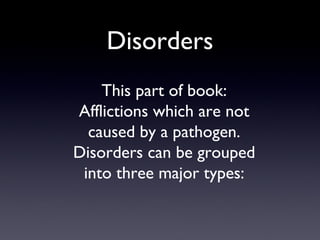Recommended
Recommended
More Related Content
Viewers also liked
Viewers also liked (11)
Kursus in design - cara menyimpan package pada adobe indesign cs6

Kursus in design - cara menyimpan package pada adobe indesign cs6
công ty dịch vụ giúp việc văn phòng tốt giá rẻ hồ chí minh

công ty dịch vụ giúp việc văn phòng tốt giá rẻ hồ chí minh
Similar to Disorders
Similar to Disorders (20)
Disorders of white blood cells and related conditions

Disorders of white blood cells and related conditions
More from ewaszolek
More from ewaszolek (20)
Disorders
- 1. Disorders This part of book: Afflictions which are not caused by a pathogen. Disorders can be grouped into three major types:
- 2. Inherited disorders • The direct result of an inherited gene (as in hemophilia, PKU, or sickle-cell anemia or an inherited tendency for a disorder (as may be the case for diabetes). Ehlers-Danlos Syndrome
- 3. Injuries • Caused by physical damage to the body, injuries may be temporary (as a bruise or minor cut), or permanent (as the loss of a leg or eye. Burns, broken bones, sprained joints, concussion, and some hearing and vision defects are the results of injuries.
- 4. Organic Disorders • These condition are not inherited or caused by injury. A deficiency disease results from improper nourishment such as the lack of a vitamin or mineral. • Chemical poisoning and radiation sickness result from environmental factors. • Strokes, ulcers, blood clots in the vessels, types of hardening of the arteries, kidney stones, gallstones and many nervous disorders are caused by unknown or only partially understood factors. • Two organic disorders: benign tumors and cancer
- 5. Benign Tumors • Occasionally a group of cells stops functioning normally and grows a structure different from the tissue of which it is part. • This abnormal growth of cells is called a tumor. • If the growth is slow and localized, it is called benign. • Some examples of benign tumors are common brown moles and certain birthmarks. • Some grow to a certain size and stop; others expand slowly, exerting pressure on the surrounding tissues.
- 7. Cancer • If the growth of a tumor is rapid and chaotic it is called a malignant tumor. • It is often called a cancer • The nuclei in the cancer cells are larger and often contain more DNA, and cell growth and reproduction are more rapid than in normal tissue or benign tumors. • Bizarre appearance and may even have an abnormal number of chromosomes
- 8. Cancer • Cancer cells may be separate and travel to other parts of the body, starting new tumors. • Who gets what kinds of cancer also depends a great deal on their genetic make-up. Certain cells in some people are naturally resistant to some forms of cancer.
- 9. • Both benign and malignant tumors may occur anywhere in the body. To diagnose which type of tumor is present, a doctor performs a biopsy. • In a biopsy a sample of tissue from the tumor is removed and sent to a pathologist, a specialist in diseased tissues. • The specimen is analyzed microscopically to determine if it is benign or malignant.
- 10. My 2nd Tumor
